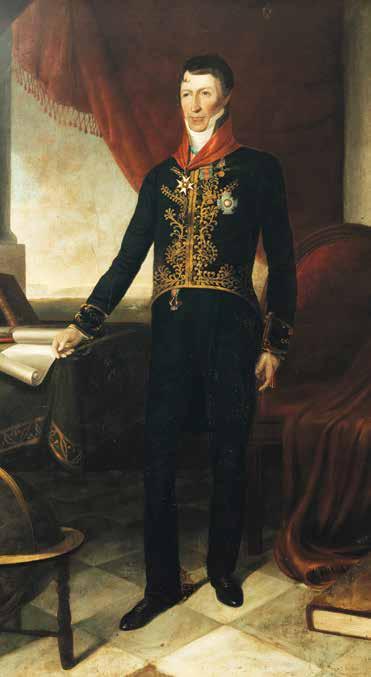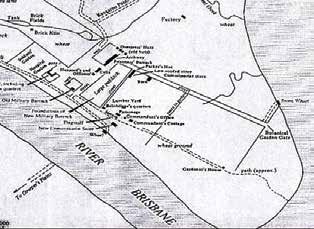
8 minute read
THE BIRTH OF BRISBANE CITY Episode 3 – Settlement
By Al Finegan
In early January 1824, not long after John Finnegan and Thomas Pamphlett were returned to Sydney by Oxley, the truth of the discovery of Brisbane River was published. Overnight Oxley was changed from hero to villain and suffered much derision from his peers. Despite this, Governor Brisbane knew he had to use Oxley to establish the new settlement in Moreton Bay. It had been a paradise for the peaceful, caring, and friendly people of the Quandamooka for millennia. That was all about to change, and not for the better.
Advertisement
On 11th September 1824, HMS Mermaid sailed into Moreton Bay with Oxley, who had been appointed to direct the new Commandant to the site he had chosen for the first settlement at Redcliffe. She rounded the south of Bribie Island and dropped anchor in Pumicestone Passage. A lookout on Mermaid called out that he could see a white man on shore. It was Parsons, having struggled back to Bribie after returning, once he realised that he was heading the wrong way. reason for establishing a settlement in Moreton Bay, Oxley decided to launch the penal colony some 20km to the north, and on a site with only a meagre water supply and located beside a shallow bay. This questionable decision was to prove a serious mistake in the months to come.

On board Mermaid was Oxley’s exploration party which, by order of the Governor, included John Finnegan to act as translator and guide. When the truth of his part in the discovery of Brisbane River became known, he was released and appointed to the planning team for the new settlement. Mermaid also carried a party of 14 soldiers with their families, 29 convicts, a surgeon, and a storekeeper, all under the command of Lieutenant Henry Miller of the 40th regiment.
On 16th September, with the convicts already at work building the slab and bark huts that were to be their gaol, Oxley decided it was time to take Allan Cunningham and Lieutenant Butler to make a more thorough examination of the river. Finnegan directed them to the mouth of the Brisbane River and continued to point out the various features and creeks along the banks. After three weeks’ exploration of the river, Oxley and his party returned to Mermaid, and sailed back to Sydney.

The next morning, under the pilotage of Finnegan, Mermaid sailed across to Redcliff. Oxley, Finnegan, and Miller went ashore to make a reconnaissance. Immediately on landing, Finnegan searched for and found, his old friend, the Chief of the village. After a friendly welcome, the news he passed on was not good. Later that day a team of soldiers and convicts landed, and a Moreton Bay penal colony was established at Humpybong, Redcliffe, now Humpybong Park.
It could be wondered why, after all the fuss of the discovery of the “noble” Brisbane River as the key
By November 1824, Governor Brisbane was keen to see the much-admired Moreton Bay for himself. He instructed Oxley to prepare for one more voyage to take him on a tour of the new settlement, and the Brisbane River. As their faithful Mermaid was undergoing maintenance, Amity, a 148ton brig was selected and prepared for the vice-regal visit. The Governor insisted that Finnegan should also be part of the party.
On arrival at the Redcliffe settlement, stores were unloaded, while the Governor and his officials remained on board preparing for their excursion up the Brisbane River. Finnegan studied the tidal movements carefully to plan the right time to depart. The next morning, the 4thDecember 1824, they loaded the whaleboat with provisions and on Finnegan’s bidding, the Governor, Oxley, and party rowed off for the Brisbane River. As Finnegan predicted, the tide swept them around Fishermans Island and into the mouth of the mighty Brisbane River. The Governor was immediately impressed with the size and beauty of the river stating that the scenery on each side was truly picturesque country. The party rowed up the river for about 40 km.
After camping out for one night they caught the ebbing tide and returned to Amity. Governor Brisbane expressed a view that the river had met all the high praise that had been lavished upon its might and beauty. He directed Oxley to organise a visit for him to inspect the Redcliff settlement in the morning. Word was sent to Lt Miller to prepare for the vice regal’s inspection. Miller ordered his troops to keep the locals at a respectful distance during the Governor’s visit. The next morning Miller was pleased that only three natives could be seen, and they were at some distance. A smiling Finnegan commented that they were just lookouts. The Governor and his aides landed to a military salute. This alerted the lookouts who signalled their Chief that someone of obvious importance was coming to visit. As the Governor inspected the troops, a small party came around a point of land led by an imposing native, ceremonially dressed in paint and kangaroo hides. In a few moments the party increased to 15 men, but no females were evident. A wave of tension passed over the Governor and his aides, fearing the intention of the approaching natives. The Chief, scanning the official party, spotted Finnegan, and immediately demonstrated extraordinary pleasure at seeing him again. There were suddenly relieved smiles all round as the Chief and Finnegan embraced. The Governor was later to report that, “The locals were very friendly, and betrayed no symptom of fear; indeed one was so extraordinarily gratified to meet Finnegan as to roll himself in the sand - from pure pleasure.” Before he left, Governor Brisbane was pleased to congratulate Lieutenant Miller, advising him that he had approved his promotion to Captain. On his return the
Governor was reported in the Gazette as saying, “I am amazingly gratified with the excursion and there can be little doubt, but that Australia will at no distant period, derive considerable and lasting benefit from the new settlement.” Prophetic words indeed!
The Governor released a statement to the press, “Red Cliff Point was deemed peculiarly eligible, from its centrical situation; the anchorage, however, is not very good off it. The settlement was left in good health and spirits, and they were rapidly proceeding in erecting comfortable huts, and the formation of little gardens. The site of the settlement was dry, and open to the sea breeze – an indispensable advantage in that hot climate” He was wrong. By the beginning of 1825, Redcliffe was struggling. By April, it had become obvious to Miller that his settlement was failing. The land was too harsh for growing crops, the mosquitoes and midges were awfully bad, and the water was even worse. The health of convicts, soldiers and their families was suffering. Redcliff was also difficult to defend. Their relations with the local Aborigines had deteriorated and he felt that they might attack the penal colony in force after already having had to defend against raids on their stores of sugar and flour.
Miller knew he had to act. He made the decision to search for a better place to establish an ever-increasing population before it was too late to move. He had a copy of Oxley’s report recommending a spot on the north bank near Frew Park at Milton. On inspection, he noted the signs of widespread flooding in low lying areas that apart from the obvious dangers of inundation, it was a breeding ground for insects. He also ignored another proposed location at Breakfast Creek. In May 1825, after several excursions, he selected a location near the current site of North Quay and William Street. He was attracted by the height offered by the banks at William Street and the elevation offered by
Wickham Terrace. He would be able to see ships coming around the Kangaroo Point reach. Miller’s choice was perfect. He marked out the triangle of land bounded on two sides by the Brisbane River conjoined by what is now the Botanic Gardens, and the escarpment which is now Wickham Terrace. He considered the area to be defendable as well as providing a natural barrier against escape by the convict population. It also had a water supply in the form of a now non-existent creek later named Wheat Creek. Most heavy stores were rowed up in the long boat while Miller led the sixty plus members of the settlement on a long slow walk up a marked track to what is now Queen Street. There they started construction, including a commandant's cottage, various bark and timber structures and other canvas tents, and slowly the settlement took shape. Miller dispatched a detailed report on the change of venue via a store ship.
When Governor Brisbane read Miller’s report, he was furious. He had already shipped a glowing report on his site selection to London, lauding his choice. Despite the sound reasons for the move detailed by Miller, Brisbane was inconsolable at what would be seen by London as poor judgement. When he was eventually told he was to be fired for disobedience, Miller was shocked and dismayed. Within six months he was replaced by Captain Peter Bishop.
Finnegan continued as an explorer acting as guide and translator during the renowned exploration of the Brisbane and Lockyer valleys by Edmund Lockyer in 1825. On return, undoubtedly with a wry smile, Lockyer expressed the opinion that, “.. it would have been more appropriate to have called the river after the man who really discovered it. Although Its discovery is, however, of more importance than whether it is called the Finnegan or the Brisbane River.”
Major General Sir Thomas MacDougall Brisbane, 1st Baronet, GCB, GCH, FRS,
FRSE (1773 – 1860), served as Governor of NSW from December 1821 to December 1825. Before he departed Sydney, he called John Finnegan to his office and issued him a pardon, and the offer of a 3 year contract as a pilot in Moreton Bay. Overwhelmed, Finnegan immediately accepted and subsequently joined the crew of the pilot ship Regent Bird, stationed in Moreton Bay. He supervised the laying and on-going maintenance of buoys to mark the safe passage into the bay and river while piloting ships into and out of Brisbane. In a twist of irony, Pamphlett had once again been found guilty of theft and was sentenced to the incredible hardships and floggings of convict life at Moreton Bay penal colony. Meanwhile Finnegan enjoyed a respected and well-paid life in comparative luxury, probably passing within a few 100 metres of Pamphlett on a daily basis. One can easily imagine a smartly uniformed Finnegan on the deck of a ship sailing up the river giving a wave to his old mate Pamphlett sweating in rags on the riverbank. Finnegan continued to work as a pilot and translator for the expanding Brisbane colony until he completed his contract in 1829. The remainder of Finnegan's life went unrecorded, although there is some evidence that he returned to Ireland.
Governor Macquarie, Brisbane’s predecessor, had criticized Oxley as being, “… loose with the facts and dissatisfied.” After the Moreton Bay expeditions, Oxley gradually withdrew from public life still carrying the burden of his shame from his false claim of “discovering” the Brisbane River and died in 1828 when only 44 years old.
Captain Henry Miller left the service and went on to start a new life as a successful businessman. The false narratives that still exist claiming that Oxley is the father of Brisbane City are evidently incorrect. Miller is the true father of our fine city, and it was the three castaways who were the true discoverers of the Brisbane River.









